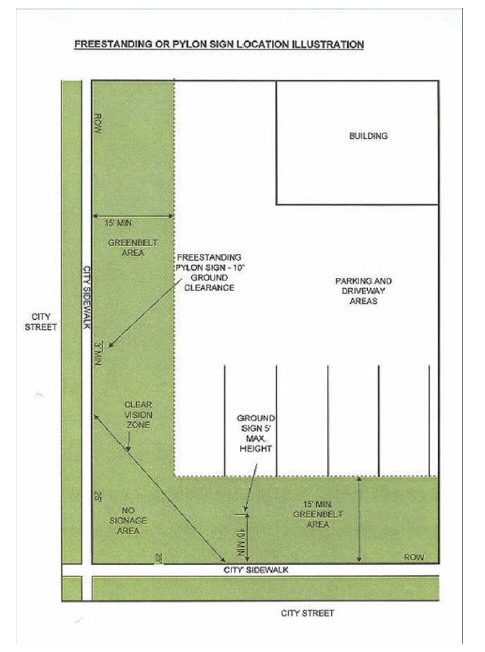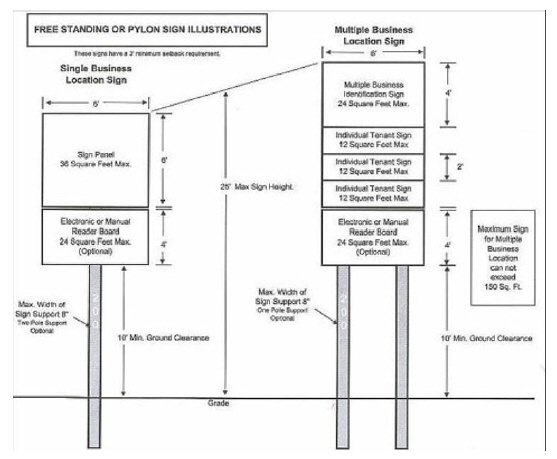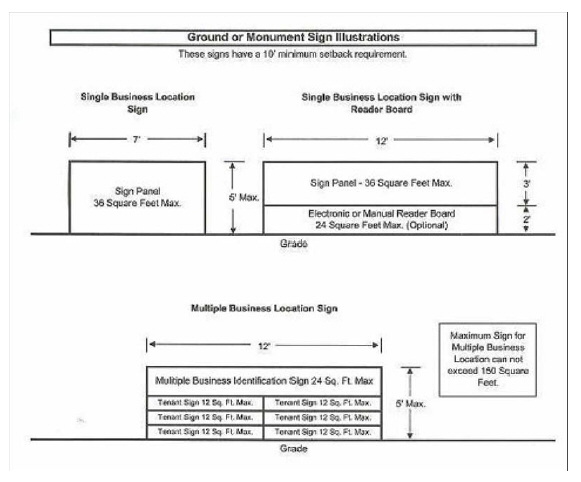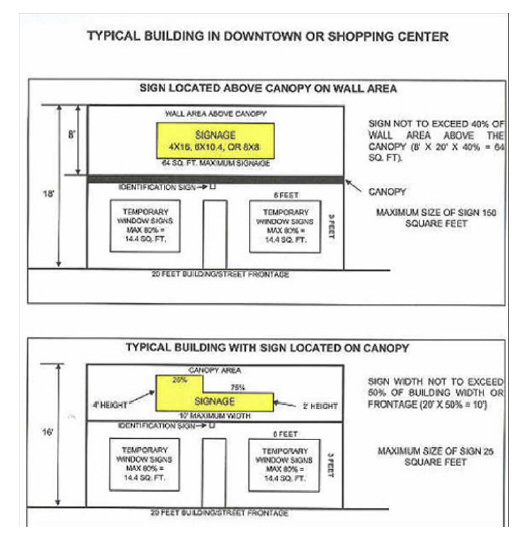Loading...
(a) (1) After the enactment of this chapter, the Building Official or his or her designee shall, as soon as practicable, survey the City for signs which do not conform to this chapter. Upon a determination that a sign is nonconforming, the Building Official or his or her designee shall use reasonable efforts to notify, either personally or in writing, the user or owner of the property on which the sign is located of the following:
A. The sign's nonconformity; and
B. Whether the sign is eligible for characterization either as legal nonconforming or unlawful.
(2) Failing determination of the sign owner, user or owner of the property on which the sign is located, the notice may be affixed in a conspicuous place to the sign or to the business premises with which the sign is associated.
(b) Legal Nonconforming Characterization. Any sign located within the City limits on the date of adoption of this chapter or located in an area annexed to the City thereafter, which sign does not conform with this chapter, is eligible for characterization as a legal nonconforming sign and is permitted, provided it also meets the following requirements. Temporary signs shall not be characterized as legal nonconforming signs.
(1) The sign was covered by a sign permit or variance on the date of adoption of this chapter if one was required under applicable law.
(2) If no sign permit was required under applicable law for the sign in question, the sign was in all respects in compliance with applicable law on such date of adoption.
(c) Loss of Legal Nonconforming Status.
(1) A legal nonconforming sign shall immediately lose its legal nonconforming designation if:
A. The sign is altered in any way in structure or copy, except for changeable copy signs and normal maintenance, which alteration tends to or makes the sign less in compliance with this chapter than it was before the alteration.
B. The sign is relocated, moved, or adjusted to a position making it less in compliance with the requirements in this chapter, e.g. within the required setback or the clear vision zone area.
C. The sign is replaced.
(2) On the happening of any one of the events described in division (c)(1), B. or C. of this section, the sign shall be immediately brought into compliance with this chapter with a new permit secured therefor, or it shall be removed.
(d) Maintenance and Repair. Nothing in this section shall relieve the owner or user of a legal nonconforming sign or the owner of the property on which the legal nonconforming sign is located from the provisions of this chapter regarding safety, maintenance and repair of signs. However, no repainting, cleaning or other normal maintenance or repair of the sign or sign structure shall modify the sign structure or copy in any way which makes it more nonconforming. In such a case, the sign may lose its legal nonconforming status.
(e) Compliance Required. Legal nonconforming signs must comply with this chapter when a change in ownership, tenancy, business, or organization occurs on the premises where the sign is located or when the advertising on the sign changes to denote a change in ownership, tenancy, business, or organization. However, this section shall not prevent the enforcement of Section 1292.23.
(Res. 24-95. Passed 2-13-95; Ord. 2002-05. Passed 6-24-02; Ord. 2007-04. Passed 10-8-07.)
(a) Maintenance and Repair of Signs. All signs and all components thereof, including, without limitation, supports, braces, and anchors, shall be kept in a state of good repair. With respect to freestanding signs, components (supporting structures, backs, etc.) not bearing a message shall be constructed of materials that blend with the natural environment or shall be painted a neutral color to blend with the natural environment.
(1) If the Building Official shall find that any sign is unsafe or insecure, or is a menace to the public, he or she shall give written notice to the owner, agent, or person having the beneficial interest in the building or the premises on which such sign is located. Correction of the safety condition which caused the Building Official to give such notice shall be effected within ten days after receipt of the notice. If such condition is not corrected after the conclusion of such ten-day period, the Building Official is hereby authorized to cause the sign to be removed forthwith at the expense of the owner, agent, or person having the beneficial interest in the building or premises on which such sign is located. Notwithstanding the foregoing provision, the Building Official is authorized to cause any sign to be removed summarily and without notice, at the expense of the owner, agent or person having the beneficial interest in the building or premises on which such sign is located, whenever he or she determines that such sign is an immediate peril to persons or property.
(2) If the message portion of a sign is removed, leaving only the supporting "shell" of a sign, the owner of the property where the sign is located, or other person having control over such sign shall, within 30 days of the removal of the message portion of the sign, either replace the entire message portion of the sign or remove the remaining components of the sign. This division shall not be construed to alter the effect of Section 1292.22, which prohibits the replacement of a nonconforming sign. Nor shall this division be construed to prevent the changing of the message of a sign.
(b) Abandoned Signs. Except as otherwise provided in this chapter, any sign which is located on property which becomes vacant and unoccupied for a period of three months or more, or any sign which pertains to a time, event or purpose which no longer applies, shall be deemed to have been abandoned. Permanent signs applicable to a business temporarily suspended because of a change of ownership or management of such business shall not be deemed abandoned unless the property remains vacant for a period of six months or more. An abandoned sign is prohibited and shall be removed by the owner of the sign or the owner of the premises.
(c) Dangerous or Defective Signs. No person shall maintain or permit to be maintained on any premises owned or controlled by him or her any sign which is in a dangerous or defective condition. Any such sign shall be removed or repaired by the owner of the sign or the owner of the premises.
(d) Unlawful Signs. No person shall erect on any premises owned or controlled by him or her any sign which does not comply with this chapter.
(e) Street Improvement Projects. Any sign projecting over a public right-of-way on the effective date of this chapter, which sign was subject to removal or relocation at the owner's expense pursuant to a permit or other ordinance of the City, shall be removed by the owner or altered at the owner's expense to comply with this chapter if, as the result of or after completion of a street improvement project, such sign does not or would not comply with this chapter.
(f) Signs Placed within the City Right-of-Way. All signs in the City of Davison are subject to Section 1292.03 of this zoning ordinance, which states that no person shall erect, alter, relocate, enlarge, or convert any sign in the City without first obtaining a sign permit. Furthermore, failure to obtain a sign permit is subject to Section 1262.99 of this zoning ordinance which states that the City may take additional lawful action that is necessary to prevent or remedy any violation of this zoning ordinance.
(g) (1) Removal by Building Official. The Building Official or his or her designee shall cause to be removed any sign that endangers the public safety, such as an abandoned, dangerous, or materially, electrically or structurally defective sign, or a sign for which no permit has been issued. The Building Official or his or her designee shall prepare a notice which shall describe the sign and specify the violation involved, and which shall state that if the sign is not removed or the violation is not corrected within 21 days, the sign shall be removed in accordance with this section.
(2) All notices mailed by the Building Official or his or her designee shall be sent by certified mail. Any time periods provided in this section shall be deemed to commence on the date of the receipt of the certified mail.
(3) For all other signs, the notice shall be mailed to the owner of the property on which the sign is located as shown on the last equalized assessment roll. If known, or with reasonable care should be known, the notice shall be mailed to or delivered to the owner of the sign and the occupant of the property.
(4) Any person having an interest in the sign or the property may appeal the determination of the Building Official or his or her designee ordering removal or compliance by filing a written notice of appeal with the Zoning Board of Appeals within 14 days after the date of mailing the notice, or within 14 days after receipt of the notice, if the notice was not mailed. When an appeal is filed, action on enforcement is suspended until a decision on the appeal has been finalized by the Zoning Board of Appeals.
(5) Notwithstanding the provisions of this division (g)(5), in cases of emergency, the Building Official or his or her designee may cause the immediate removal of a dangerous or defective sign without notice.
(h) Disposal of Signs; Fees.
(1) Any sign removed by the Building Official or his or her designee pursuant to division (g) of this section shall become the property of the City and may be disposed of in any manner deemed appropriate by the City. The cost of removal of the sign by the City shall be considered a debt owed to the City by the owner of the sign and the owner of the property, and may be recovered in an appropriate court action by the City or by assessment against the property as hereinafter provided. The cost of removal shall include any and all incidental expenses incurred by the City in connection with the sign's removal.
(2) When it is determined by the Building Official or his or her designee that the sign would cause an imminent danger to the public safety and contact cannot be made with a sign owner or building owner, no written notice shall have to be served. In this emergency situation, the Building Official or his or her designee may correct the danger, all costs being assessed as follows:
A. The notice given by the Building Official or his or her designee shall state not only the remedial action required to be taken, but shall also state that if such action is not taken within the time limits set forth in this chapter, the cost of correcting the unlawful feature of the sign may be assessed against the property on which the sign is located, together with the additional 5% for inspection and incidental costs and an additional 10% penalty for the cost of collection, and that such assessment shall be collected in the same manner as real estate taxes against the property.
B. If the owner of the premises, the person entitled to the possession thereof, or the owner of the sign fails, neglects, or refuses to comply with the notice to repair, rehabilitate or demolish the sign declared to be unlawful, then any such owner or person entitled to possession of the premises, if other than the owner of the premises, or all of them, may be prosecuted for a violation of this chapter. The Building Official or his or her designee may remove the sign declared to be unlawful.
C. If it becomes necessary for the Building Official or his or her designee to remove a sign pursuant to this division, bids shall be taken when the estimated costs of demolition exceed five hundred dollars ($500.00). When completed, the Building Official or his or her designee shall certify to the City Clerk the legal description of the property upon which the work was done, together with the name of the owner thereof, as shown by the City of Davison tax rolls, together with a statement of work performed, the date of performance and the cost thereof.
D. Upon receipt of such statement, the City Clerk shall mail a notice to the owner of the premises as shown by the tax rolls, at the address shown upon the tax rolls, by certified mail, postage prepaid, notifying such owner that the work has been performed pursuant to this chapter, stating the date of performance of the work and the nature of the work and demanding payment of the costs thereof (as certified by the Building Official or his or her designee), together with 5% for inspection and other incidental costs in connection therewith. Such notice shall state that if such amount is not paid within 30 days of the mailing of the notice, it shall become an assessment upon and a lien against the property of such owner, describing the same, and will be certified as an assessment against the property, together with a 10% penalty, for collection in the same manner as real estate taxes upon the property are collected.
E. If the City Clerk does not receive payment within a period of 30 days following the mailing of such notice, the City Clerk shall inform Council of such fact, and Council shall thereupon enact a resolution assessing the whole cost of such work, including 5% for inspection and other incidental costs in connection therewith, upon the lots and tracts of land from which the sign has been removed, together with a 10% penalty for the cost of collection.
F. Following passage of such resolution upon third reading, the City Clerk shall certify the same to the City Treasurer, who shall collect the assessment, including the 10% penalty, in the same manner as other taxes are collected.
G. Each such assessment shall be a lien against each lot or tract of land assessed, until paid, and shall have priority over all other liens except general taxes and prior special assessments.
H. For purposes of this section, the owner of the premises shall be presumed to be the owner of the sign thereon, unless the contrary appears from facts brought to the attention of the Building Official or his or her designee.
(3) If costs are to be assessed against the property, a hearing to confirm the costs shall be held before Council. At such hearing, the owner of the property or other interested person may appear and object to the proposed assessment. Notice of the hearing shall be given to the property owner at least ten days prior to the date of the hearing by mailing a notice of the hearing to the address of such property owner as shown on the last equalized assessment roll.
(Res. 24-95. Passed 2-13-95; Ord. 2002-05. Passed 6-24-02; Ord. 2007-04. Passed 10-8-07; Ord. 2010-08. Passed 3-8-10.)
(a) Sandwich board signs are exclusively permitted within the defined central business district within the Downtown Development Authority. This defined area is bordered on the south by the railroad tracks, west by M-15 (State Street), north by Third Street, and east by a line beginning on the south at railroad tracks aligning with the fence along the eastern edge of merchants parking lot directly north to Third Street.
(b) Permitted Sign Types.
(1) Signs shall be a sandwich board type with multiple (minimum of two) or one continuous hinge across top.
(2) Signs must be portable and are intended to be set on the sidewalk.
(c) Signs shall have a maximum height of 42 inches and a maximum width of 24 inches. The minimum height of a sandwich board shall be not less than 36 inches and a minimum width of not less than 20 inches.
(d) Design.
(1) All sandwich board signs shall be maintained in a high-quality state, with no peeling, broken, cracked, or faded paint/vinyl.
(2) Lettering shall have crisp and sharp edges with a professional quality, either painted or vinyl.
(3) Signs are to have a flat surface.
(4) Signs shall have no more than two sign faces.
(5) Signs are intended to contain the name of the business it is intended to advertise on both sides.
(6) Signs shall not be illuminated, animated, have moving parts, or be electrically powered in any way.
(7) Signs shall contain a device (such as a chain, rope, cable, etc.) to prevent sign panels from spreading open and collapsing onto the ground.
(8) Edges shall have no protruding features that extend beyond the edges of the sign.
(9) Signs may contain three-dimensional type lettering and/or objects contained within overall area limits of the sign.
(10) Removable signage panels on thin sign board material such as aluminum, Centrex, or other quality sign grade material shall be attached to the sign frame with screws or through the use of slide rails. These materials are necessary to ensure high-quality interchangeable sign panels while enhancing the versatility of the sign. Flimsy fixtures including, but not limited to, Velcro, staples, or double sided tape, are not permitted.
(11) Signs are encouraged to be unique creations that have a high-quality appearance, reflecting creative hand-made craftsmanship through carvings, paintings, and other unique sign-making techniques.
(12) Combinations of sign colors are encouraged because they ensure contrast and clarity. The following color palette is suggested:
A. Background: Black, brown, dark green, medium to dark blue, burgandy.
B. Lettering: Black, brown, medium blue, medium to dark green, burgandy, goldenrod, and white.
(13) Signs may be a silhouette cut into a shape. Protruding features extending beyond the limits of the sign area that could cause a hazard to pedestrian traffic are not permitted.
(14) Temporary hand lettering is permitted only on a chalk or white board section of the sign comprising of an area not greater than 60% of any one side of sign, such as: "Daily Specials'' or "Sale Today" applications. This chalk or white board section may be on one or both sides of sign.
(e) Construction Materials.
(1) Signs shall be constructed using quality exterior sign board materials.
(2) Suggested materials: MDO board, Centrex, Alumiply, high density foam board, plastic (with weights).
(3) Materials not recommended (due to temporary exterior quality): Cardboard, OSB, plywood, Coraply, or Masonite.
(4) Signs shall not be constructed from materials that may cause a hazard to pedestrian traffic.
(5) Signs constructed with light materials such as plastic shall be weighted so they can remain stationary on windy days.
(6) Sign panels that are loose or lightly attached are not permitted.
(7) Items that are attached loosely or lightly to the sign panels are not permitted.
(f) Installation.
(1) Each building, including buildings with more than one (1) tenant, with exterior frontage is permitted to display one (1) sandwich board sign at a time.
(2) Placement on landscaped areas in front of business, between frontage of building and sidewalk is permitted. However signs are not permitted in landscaped areas between sidewalk and curb.
(3) If a business owns private property between the building and the sidewalk, the sign must be located in this area.
(4) Sandwich board signs do not have permanent fixtures. Therefore, they are placed outside of the business only during business hours and must be removed and placed indoors daily for storage after the close of business.
(5) Location of sign must be within fifteen (15) feet of the business entry on the sidewalk as far from the curb as possible and within business frontage of the building. Signs are not permitted to restrict the width of permissible sidewalk egress from the City's minimum commercial sidewalk width requirements.
(6) Signs are not permitted to be placed in front or adjacent to another business, commercial enterprise, or vacant land. In addition, placement of such signs is prohibited on City property (except within the permitted sidewalk right-of-way), including but not limited to parking lots, streets, or alleys.
(g) Examples of acceptable signs:

(h) Maintenance. Sandwich board signs must conform to the requirements set forth in Section 1292.09.
(i) Approval. Approval of sandwich board signs are subject to the permit requirements of Section 1292.03.
(j) Exceptions. Requests for exceptions from the regulation of sandwich board signs are subject to the administrative review requirements of Section 1292.08.
(Ord. 2007-04. Passed 10-8-07.)




